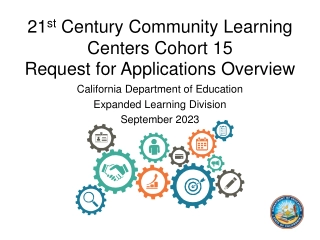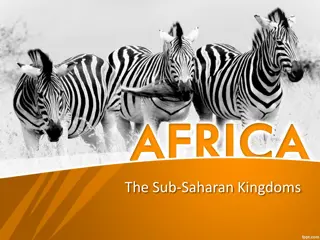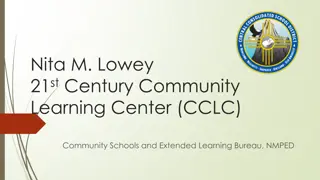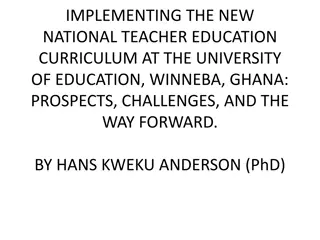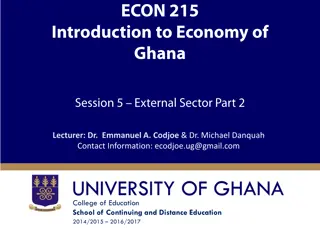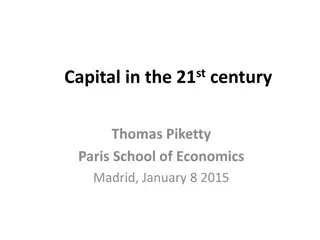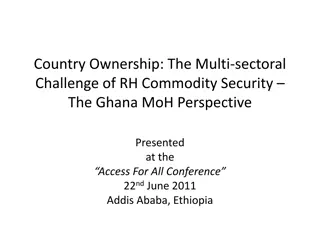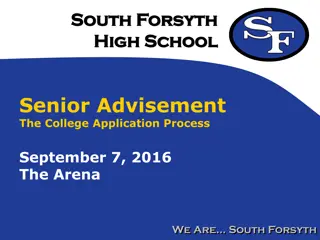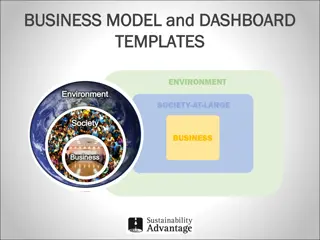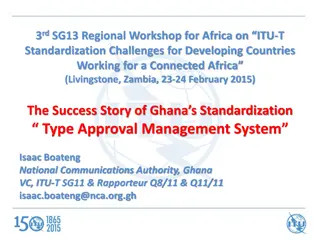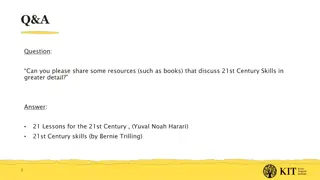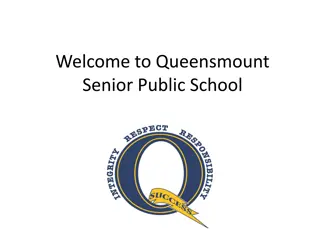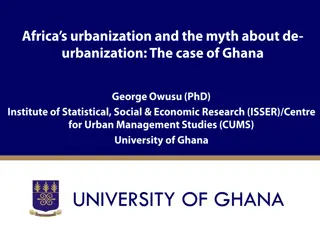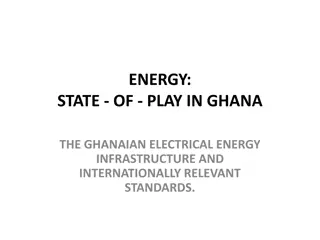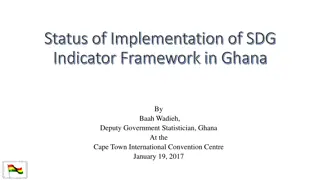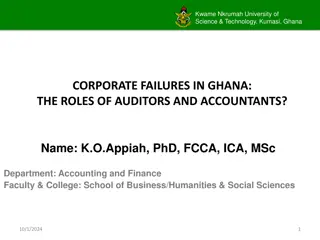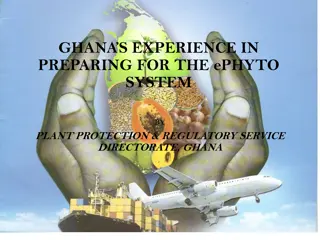Transforming Ghana's Senior High School Education System for the 21st Century
Ghana's education sector is undergoing significant reforms to equip young people with the skills and competencies needed for lifelong learning and employability. The aim is to create an inclusive, flexible system that reflects stakeholder voices, integrates STEM education, and emphasizes 21st-century skills. The reform covers curriculum review, assessment system revision, and teacher education alignment to ensure Ghana's youth are prepared for the challenges of the global knowledge economy.
Download Presentation

Please find below an Image/Link to download the presentation.
The content on the website is provided AS IS for your information and personal use only. It may not be sold, licensed, or shared on other websites without obtaining consent from the author.If you encounter any issues during the download, it is possible that the publisher has removed the file from their server.
You are allowed to download the files provided on this website for personal or commercial use, subject to the condition that they are used lawfully. All files are the property of their respective owners.
The content on the website is provided AS IS for your information and personal use only. It may not be sold, licensed, or shared on other websites without obtaining consent from the author.
E N D
Presentation Transcript
Senior High School Education in Ghana: The Challenging Path to Reform N.A Owusu-Ansah - University of Education Winneba, Joyce Anku University of Ghana, Rebecca Arther - University of Education Winneba Akwasi Addae-Boahene Chief Technical Advisor T-TEL, Bea Noble-Rogers Key Advisor T- TEL, Eric Ananga Key Advisor T-TEL.
Outline Background to the Reform Scope to the reform Lessons Learned from Previous Reform Progress Towards Implementation and Reform The Phases of the Reform Key Principles and Practices Underpinning Reform Preparation for Implementation in Schools Trialling the Curriculum, part 1 and 2 External and Internal Evaluation Reviewing and Finalising Writing the New Teacher Education Curriculum Challenges and Solutions Reconceptualising High Quality SE, Teaching and Assessment
Background to the Reform: Why Change the Senior High System? The Goals to ensure a secondary education system which enables all Ghanaian young people to acquire the 21stCentury skills, competencies, knowledge, values, and attitudes needed for lifelong learning, employability, and adult life. to secure the future prosperity and wellbeing of the country to create a system inclusive of all learners, flexible, robust, and fully reflecting the voices of stakeholders to build on existing reforms: the new standards based primary school and JHS curricula, and develop a standards based SHS curricula
The Scope of the Reform review and revision of the High School Curriculum and the Technical and Vocational Curriculum, to include flexible learning pathways, an integration of STEM and of 21stC skills and competencies review and revision of the assessment system to end the supremacy of rote learning. review and revision of the SHS Teacher Education Curricular fully aligned with the new school curriculum development of CPD materials for supporting the effective implementation of the new curricular for school leaders, teachers, tutors, mentors and others with responsibilities in education create Senior High Schools as centres of learning for young people and teachers
What is Our Ambition as a Country? Equipping young people with 21stCentury Skills and competencies, social and emotional learning and character development in addition to proficiency in literacy and numeracy, to future proof Ghana s ability to prepare the next generation to contribute and participate in the global knowledge economy
Challenge for the Reformers: to Build on Lessons Learnt from the Reform of Teacher Education 1. Multi stakeholder and political engagement and participation is essential, the reform required the legal and political weight of Cabinet approval and policies and the commitment of stakeholders 2. Build capacity in the system, developing national expertise, through curriculum writing 3. Support for implementation undertaken by national experts 4. Implementing the Curriculum effectively required weekly, PD Sessions, led by the implementers themselves: changing beliefs about pedagogy and assessment strategies needs ongoing support 5. Curriculum focused professional development to strengthen leadership and management teams 6. Ensuring relevant resources and infrastructure are available and accessible
Progress towards Reform and Implementation: Phases of the Reform Integrating 21stCentury Skills into the vision for Secondary Education Learning Areas and Programmes, integ. STEM Pedagogy and assessment: engaging, challenging and GESI responsive. Preparation for work, further study and adulthood Focused on pedagogies, assessment and content of SHS Learning Areas and Programmes and Integrating the vision for SHS GESI responsive Pedagogies Supported Teaching in School Formative and summative assessment against NTS Phase One: Secondary School Curriculum (Completing Final Draft) Phase Two: Secondary School Teacher Education Curriculum
Key Principles and Practices Underpinning the Curriculum Integrate with content the development and application of 21st Century Skills and Competencies, Gender Equality, and Social Inclusion (GESI), Social and Emotional Learning (SEL),Use of ICT, and functional skills Focus on STEM, including agriculture, and literacy within subjects Use a developmental model that focuses on learner progress over time Use interactive pedagogical approaches and assessment strategies Focus on the knowledge hierarchy: beyond re-call Integrate preparation for the world of work, adult hood and further study
THE MIXER THE MIXER INTEGRATING THE KEY INGREDIENTS OF THE CURRICULUM GESI & Social GESI & Social Emotional Learning Emotional Learning 21 21st st Century Skills Century Skills STEM Knowledge Hierarchy Knowledge Hierarchy Content Content Interactive approaches Interactive approaches AfL, AaL & AoL AfL, AaL & AoL to T&L to T&L Key Challenge: this essential integration is NOT familiar to teachers, school leaders or society where focus on content is the norm Pedagogy and Assessment Pedagogy and Assessment
Changes to Assessing SHS Learners To achieve the vision and goals for the new SHS Curriculum the approach to assessment needs to change The current system over emphasises summative assessment, assessment of learning {AoL}, focussed on re-call and externally written national examination outcomes. Little regard is given to school-based assessment and what teachers assess in class, continuous or formative assessment ( assessment for {AfL} and as learning {AaL}) The Secondary Education Assessment Guide (SEAG), written to guide to how learners are assessed in SHS Key challenge: this is a major change is assessment. Which countries have been successful at shifting the focus of assessment? Of trusting teachers with assessment? And what are the steps to success?
Key Strategies for Successful Implementation and Effective Reform of SHS Education: Testing the curriculum s fitness for purpose before finalizing writing Trialing the Curriculum Part 1 and 2 External and internal expert curriculum review and evaluation Working with set piece schools Curriculum Driven Professional Development Weekly sessions for school staff before, during and after implementation On going support for developing high quality school leadership and management teams Professional Learning Communities established in schools for teachers and leaders
Key Strategies for Successful Implementation and Effective Reform of SHS Education Schools established as learning organizations Transparent systems put in place for strengthening formative assessment Guidance and counselling systems built to support well being Accountability and Quality Assurance systems strengthend for ongoing monitoring, evaluation, review of implementation and improvement planning Stake holder focus groups and ongoing consultation and oversight Focused attention on attracting and retaining sufficient high-quality staff to secondary institutions
Key Strategies for Effective Reform of SHS Education: Creating a New Teacher Education Curriculum National Expert Team Review and revision of teacher education policy documents to align them to the SHS Curricular Writing a New Teacher Education Curriculum Writing Guide driven by the principles, practices and content of the Schools Curriculum Consultation, and work with the universities to ensure they write SHS Teacher Curriculum based on the Curriculum Writing Guide balanced against existing structures On going engagement with Examination boards Development PD materials for tutors and mentors
System Challenges System Challenges Changing experience related beliefs and practices: the role of secondary education deep integration of 21st C skills and competencies, GESI the purpose of assessment The place of school placements Supported Teaching in School Building a culture of PD and learning Acceptance of education curricula as dynamic rather than largely static Ensuring appropriate infrastructure and resources
Secondary Education Curriculum Trial: Students Voice https://youtu.be/V6oko4QlosI
Discussion: your critical questions for us and your recommendations for our next steps What steps have we missed? What should we be mindful of, addressing the challenges? What other strategies should we deploy? What are the unforeseen challenges?



